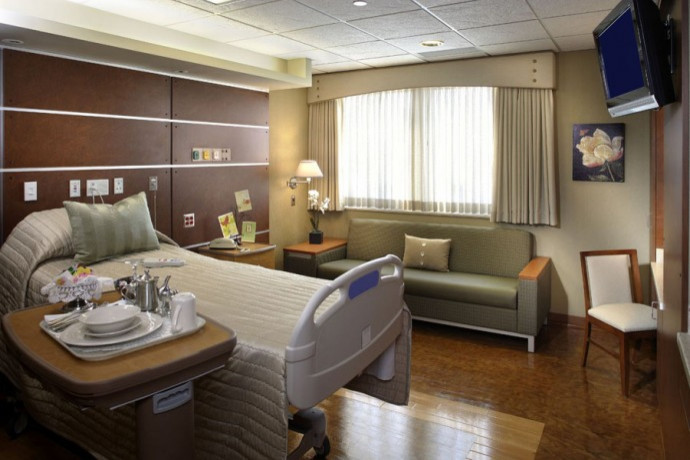Hospitals or five-star hotels?

From hotel-style room service to massage therapy to magnificent views, hospitals, particularly those in competitive urban markets, are increasingly advertising their luxury services in a bid to gain market share.
The Ronald Reagan UCLA Medical Center, a $829 million replacement for a facility that was damaged in the 1994 Northridge earthquake, opened in 2008. Radio, print, and outdoor advertisements touted its 'Better Way to Get Better' quality with private and family-friendly rooms, magnificent views, hotel-style room service for meals, massage therapy, and 'a host of other unexpected amenities'.
Perhaps as a result, the proportion of patients who say they would definitely recommend Ronald Reagan UCLA to family and friends has increased by 20 percent (from 71 percent to 85 percent), according to the Hospital Consumer Assessment of Healthcare Providers and Systems.
Before the 1990s, hospitals attracted patients by recruiting talented physicians or by investing in high-tech medical capabilities. Now, many compete for patients directly through hotel-like perks. This development raises a variety of questions, such as how amenities may influence the definition of hospital quality or affect healthcare costs.
A new article, published in the New England Journal of Medicine, raises crucial questions about the role of amenities in hospital care, explaining how deciding the value of the patient experience could have a significant effect on health care costs.
Though amenities have long been relevant to hospital competition, they seem to have increased in importance — perhaps because patients now have more say in selecting hospitals, explained author John Romley, an economist with the Schaeffer Center for Health Policy and Economics at University of Southern California.
The hospital market is booming. National spending on hospitals exceeded $700 billion in 2008 and is growing rapidly.
When Thomas Seitz sought out a hospital for treatment of his liver disease, the perks were nearly as important as the quality of care. The 58-year-old retired commercial fisherman from Ocean City wanted a private room — free from the noises of another patient — with some additional amenities that reminded him of home.
Thomas Seitz wound up going to Franklin Square Hospital Center in Rosedale. There, he channel-surfed on a flat-screen TV with a remote that could also adjust the room lighting or request room-service meals, according to the Baltimore Sun.
Franklin Square's seven-story addition, which opened in November, has a spacious new main entrance filled with natural light; a 24-hour room service menu which will soon feature comfort foods like milkshakes; and private rooms each equipped with a safe, full bathroom and pullout bed for guests.
The Marburg Pavilion at Johns Hopkins Hospital offers amenities at an additional cost, such as wood furnishings, in-room fax machines and entertainment centers, overnight sleeping accommodations for family members, VCRs and access to a video library, the Baltimore Sun reported.
Why do amenities matter so much? Perhaps patients simply don't understand clinical quality. Data on clinical quality are complex, multidimensional, and noisy, and they have only recently become systematically available to consumers. Consumers may be making choices on the basis of amenities because they are easier to understand.
Empirical evidence and surveys seem to confirm that patients increasingly value the non-clinical experience more than measures of clinical quality, such as a hospital's risk-adjusted mortality rate.
In a 'Perspectives' piece in New England Journal of Medicine, the authors cite their own research showing that Medicare patients often do not choose the hospital nearest to them. They are willing to travel -- and not necessarily for better clinical care, even in cases involving heart attack, where risk of death should be an overriding concern.
Rather, the proportion of patients who received care at a given hospital was strongly correlated to the quality of amenities. Improved perks also have a significant effect on hospital volume.
On a societal level, the value of amenities is important because our health care system currently pays for them, explained lead author Dana Goldman, director of the Schaeffer Center.
A hospital seeking to strengthen its financial position might view investment in amenities as a sound strategy to attract patients. The question is, however, what effect such a strategy might have on patients' outcomes as well as on overall health care costs, said Goldman.
The researchers note that if amenities create environments that patients and providers prefer, the result may be better treatment and improved health outcomes. Accounting for patient experience can either help us determine whether amenities are necessary to better performance or tell us if hospitals should shift their focus entirely to clinical quality instead.
As health care reform moves forward, we need to decide whether amenities are a valuable part of the hospital experience, Romley said. If they are, policymakers should include them in the measures for overall quality, prices and productivity.
© Copyright IBTimes 2024. All rights reserved.





















